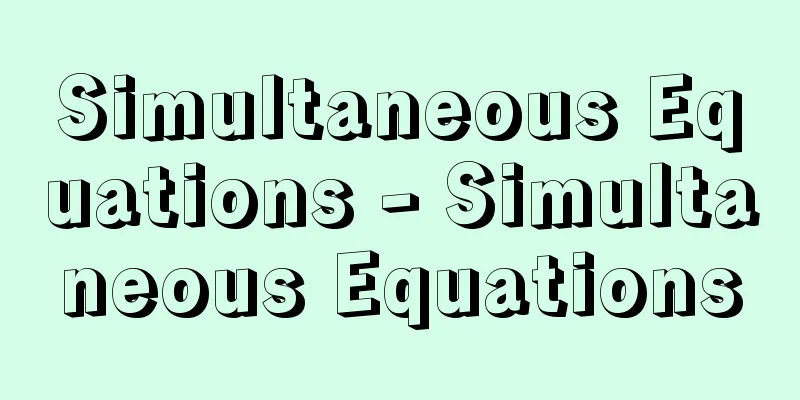Simultaneous Equations - Simultaneous Equations

|
When there is a set of equations containing two or more unknowns (multiple equations), and unknowns represented by the same letter have the same value in each equation, the set of equations is called a simultaneous equation, and the set of unknown values that make all the equations true simultaneously is called the solution (root) of the simultaneous equations, and finding all the solutions (solution set) is called solving the simultaneous equations. When each equation is linear, it is called a simultaneous linear equation, and when each equation is quadratic (or may include linear), it is called a simultaneous quadratic equation. [Yoshio Takeuchi] Solution of simultaneous linear equations with two unknowns
(2) Substitution method: Substitute the value of x obtained from [1] into x in [2] to solve the equation for y. (3) Addition and Subtraction To make the coefficient of y uniform, multiply both sides of [1] and [2] by 4 and 3 respectively, and add the sides together to get 17x = 34, from which we get x = 2. All of the above methods involve eliminating one unknown and creating an equation with the other unknown. This is called eliminating the unknown from [1] and [2] (the elimination method). The method of solving general simultaneous linear equations is closely related to the theory of determinants and matrices. It is said that the origin of determinant theory lies in the method of solving simultaneous linear equations. For the geometric meaning of the solution of simultaneous equations, and the indeterminate and impossible solutions, please refer to the "Linear Equations" entry. [Yoshio Takeuchi] Solving simultaneous quadratic equations with two unknowns The general form of a quadratic equation with two variables is ax 2 +bxy+cy 2 +ex+fy+g=0 [Yoshio Takeuchi] [Reference item] |Source: Shogakukan Encyclopedia Nipponica About Encyclopedia Nipponica Information | Legend |
|
二つ以上の未知数を含む方程式(多元方程式)の組があって、同じ文字が表す未知数は各方程式において同じ値をとるものとするとき、これら方程式の組を連立方程式といい、すべての方程式を同時に成り立たせる未知数の値の組を、連立方程式の解(根(こん))といい、すべての解(解集合)を求めることを連立方程式を解くという。各方程式が一次であるものを連立一次方程式、各方程式が二次(または一次を含んでよい)であるものを連立二次方程式という。 [竹内芳男] 連立二元一次方程式の解法
(2)代入法(置換法) 〔1〕から得たxの値を〔2〕のxに代入してyの方程式 (3)加減法 yの係数をそろえるために〔1〕〔2〕の両辺をそれぞれ4倍、3倍して、辺々を加えると17x=34となり、これからx=2が得られる。 以上の方法はいずれも一つの未知数を追い出して、他の未知数の方程式をつくることである。これを〔1〕〔2〕から未知数を消去するという(消去法)。一般の連立一次方程式の解法と行列式や行列の理論は密接に関連する。行列式論の起源は、連立一次方程式の解法にあるといわれている。なお連立方程式の解の幾何学的意味や、解の不定、不能については「一次方程式」の項目を参照されたい。 [竹内芳男] 連立二元二次方程式の解法二元二次方程式の一般形は [竹内芳男] [参照項目] |出典 小学館 日本大百科全書(ニッポニカ)日本大百科全書(ニッポニカ)について 情報 | 凡例 |
>>: Simultaneous quadratic equations
Recommend
Calliope - Calliope
Check out the Muse page. Source: Encyclopaedia Br...
Derry down Derry (English) DerrydownDerry
…Although he suffered from epilepsy and asthma, h...
ant-loving beetle
...A general term for insects belonging to the fa...
Caterpillar wasp - Caterpillar wasp
An insect belonging to the order Hymenoptera and ...
Battle of Nagashino
A battle fought in 1575 near Nagashino in Mikawa P...
Yoshishobugyo - Kisshobugyo
〘Noun〙 One of the job titles in the Muromachi Shog...
Thermomechanical treatment - Kakou Netsushori
A general term for a method of combining plastic p...
Hydrofluoric acid (Hydrofluoric acid)
An aqueous solution of hydrogen fluoride (HF). Als...
Basel Art Museum - Basel Museum (English name) Kunstmuseum-Öffentliche Kunstsammlung Basel
This art museum is located in Basel, Switzerland. ...
Soukyuu
1761-1842 (11th year of the Horeki era - 13th year...
Calico Controversy - Calicoronso
...J. Child, C. Davenant, N. Bourbon, D. North an...
Kama, S.
… [Ken Akasaka] [history] The original indigenous...
Tulsi (English spelling)
A perennial plant that is worshipped as a sacred h...
Liquidity Trap - Liquidity Trap
When market interest rates are sufficiently low co...
Shih-wu xue-tang; Shih-wu hsüeh-t`ang
A school in late Qing China. It was founded in Cha...









